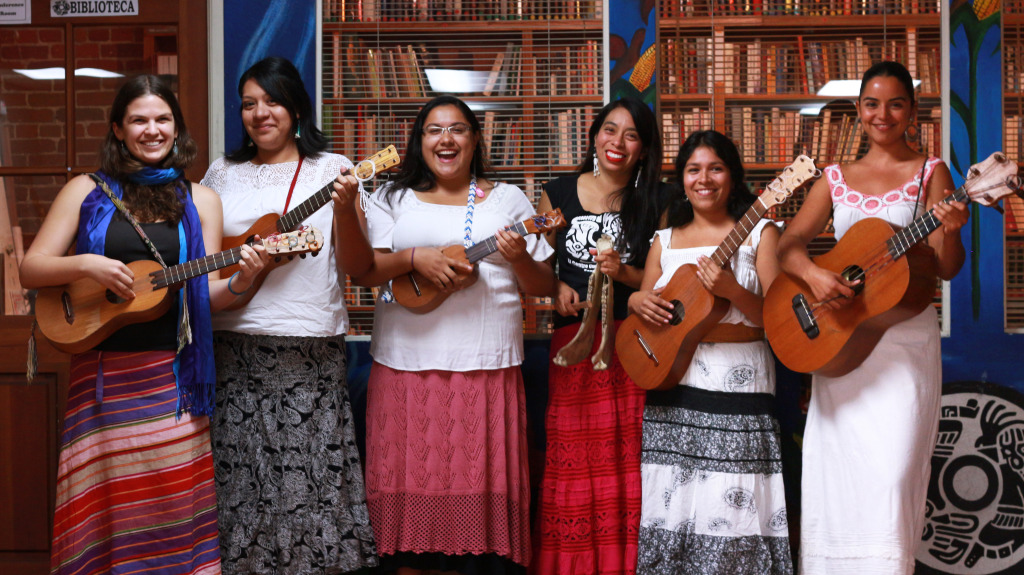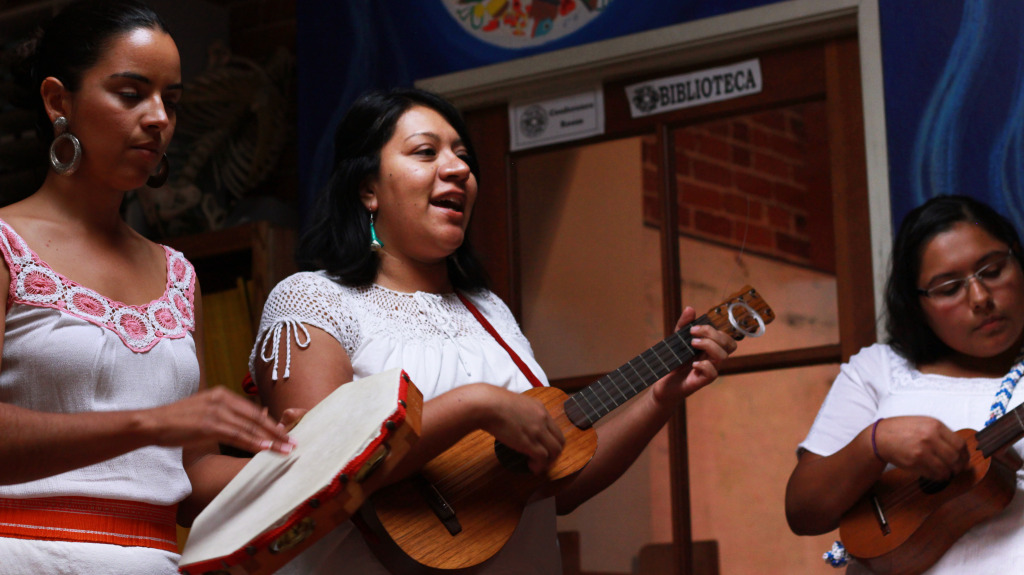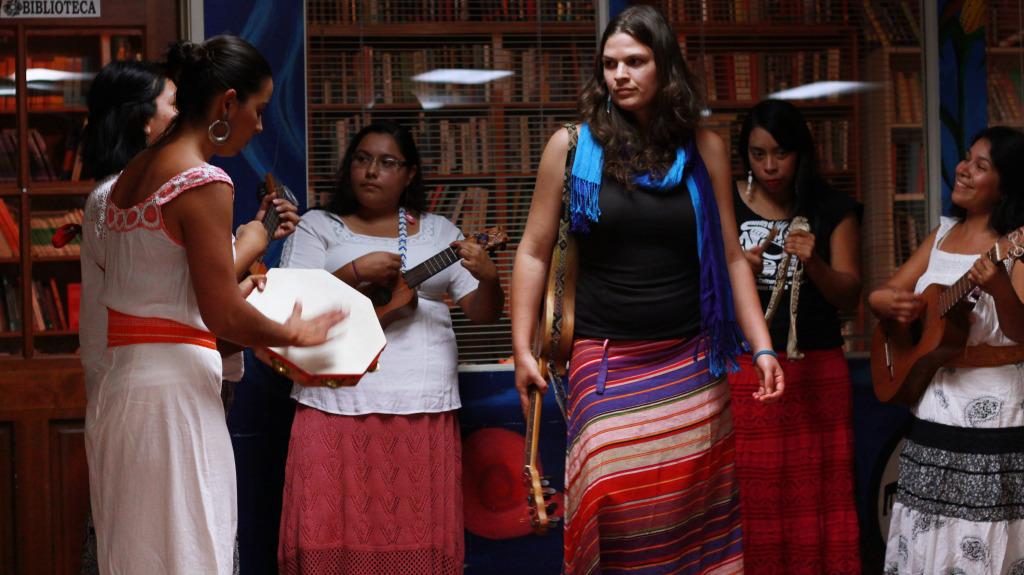by Candace Hansen
Photos by Jessica GZ
In a small brick building tucked behind the Orange County Bar association the sound of feet tapping rhythmically accompanies beautiful vocal melodies and the fierce strumming of a jarana. Voices resonate throughout the empty parking lot of the downtown district and get lost in the night breeze. The building has been christened Orange County’s leading finishing school for radicals. It’s not an underground punk or hardcore venue or even a coffee shop- it’s El Centro Cultural de Mexico, a non-profit community center that boasts free classes and events ranging from art shows to workshops. On this chilly Tuesday evening, the women of Santa Ana’s Son Jarocho community have arrived early and are warming up for class.
Son Jarocho music started in Veracruz, Mexico. It is the traditional music of the South-Eastern Mexican countryside. For Mexican Americans this style of music has become a way to connect with their roots. Like many others cities, Santa Ana has created a community where activism, social justice, music, song, and dance have become one. The heart of Son Jarocho music is a pulsing rhythm played on a large box called the tarima. Tonight, Ana dances on the box executing grace and style while not missing a single beat; stomping and stepping with dynamics, power, and precision. Michelle keeps perfect time on the quijada hitting every downbeat and tastefully filling in with a guiro style scrape of the teeth of the donkey’s jawbone. They both drive the rhythm while belting out vocals. Four stringed instruments make up the melody- Yuri plays the jarana segunda with a fierce biting tone, Carmen L plays her Ito with conviction, Teri rhythmically strums her tercera and Carmen holds down tasteful vocal harmonies and fills out the sound with the booming bass tones of her full size tercera.
Son Jarocho is popular music rooted to people, particularly farmers living in communal style countryside ranchos, which has made its way all over the world. Its roots are mestizo, mixing African, European, and Indigenous cultures. Not really intended for a stage or to pump out what we would consider to be rock stars or super groups, Son Jarocho is fluid, and a way for people to connect, spend time with others, travel, and create community. The songs are inviting and familiar, beautiful and tragic. Some say that it’s the manifestation of a value system where people need each other. Its practices breed inclusion and respect, for each other, community, history, and tradition. For these reasons Son Jarocho to many is a representation of cultural resistance in the face of outside forces.
“This became my therapy.”
Son Jarocho builds communities wherever it manifests itself. For transplants living in the US it is an opportunity to touch and taste a living part of history and culture that for some is a familiar reminder of home, and for others is the opportunity to engage in a living history of heritage. In 2007 Yuri began attending Son Jarocho classes in Santa Ana and found it to be her therapy. In 2011 she had the opportunity to travel to Veracruz and study with some of the most involved people in the Son Jarocho movement in the world. She tells us the story of how she learned to embrace her femininity on the tarima and how inspired she was after being part of the learning community that summer. “I have a little bit of all my teachers in me when I dance.” Teri traveled to many places; “I feel like Son Jarocho has allowed me to connect to a community in the many places I have gone.” Carmen L was first brought to Son Jarocho at California State University Fullerton. “I knew how powerful it was immediately,” she remembers, “it brought me to all of these women.” Son Jarocho is “Neither here, neither there” she states. After coming to the US when she was a very young girl, she is able to empathize with Son Jarocho in that feeling of being between places.
“It exposed me to a space of organizing.”
Ana is from Colima and has been part of the Son Jarocho collective at El Centro Cultural de Mexico in Santa Ana for many years. She impresses how formative El Centro has been in her life, particularly in creating a space for her to learn to organize and cultivate her activism. One day she decided to go on a trip that changed her life. She went to many places, one of them being Veracruz. She was struck by the way that people, not corporations or labels, own the music of Son Jarocho. The United States has created a Son Jarocho community that is as equally committed to social justice as traditional Son Jarocho culture. For Ana and many others, the collectivism of Son Jarocho is a refuge from the consumer driven culture that we live in. The women talk about how everything is privatized in the US, even sometimes our emotions. In this culture of maximizing and monetizing, it becomes radical to value the interactions we share with one another as well as ourselves. Sharing is not common in US culture, but within Son Jarocho the music, time, and space are all a celebration of the collective.
Carmen C, the woman playing full size tercera at the beginning of our introductions, reminds us how women and men both play an important role in the music and culture of Son Jarocho. Collectivism is critical; being mindful of each other musically is the only way to pull off the rhythms and harmonies that make Son Jarocho what it is. While Son Jarocho aims to bring people back to a state of collectivism and community, some people feel restricted by the existence of traditional gender roles. Some things are changing though; in some cities there are strong gay male centric populations of Son Jarocho musicians and performers taking on traditionally female roles. For women existing outside of the binary, the dance of balancing their perceived and internal femininity and masculinity is both a celebration and a challenge. As traditional as gender may be, Carmen C reminds us that through music “we can transcend who we are and have true solidarity.”
The social justice aspect of Son Jarocho is both outright and inherent. In Santa Ana, many people involved in the Son Jarocho community are also actively engaged in local social justice organizations like the Santa Ana Boys and Men of Color organization working to stop the criminalization of young boys and men of color. And groups like COPWATCH Santa Ana which works to inform the public of when and where the police checkpoints are located that yield more deportations and car impoundments of sober undocumented families than drunk drivers and to educate people on how to create and sustain justice at the local community level. On top of all of this amazing community work that they do, many of them teach Son Jarocho classes at El Centro Cultural on a regular basis and keep up their own work and school commitments. The woman of the Santa Ana Son Jarocho scene work tirelessly to create community; their work is a form of resistance against oppression and colonization within their own communities and within the US at large.




